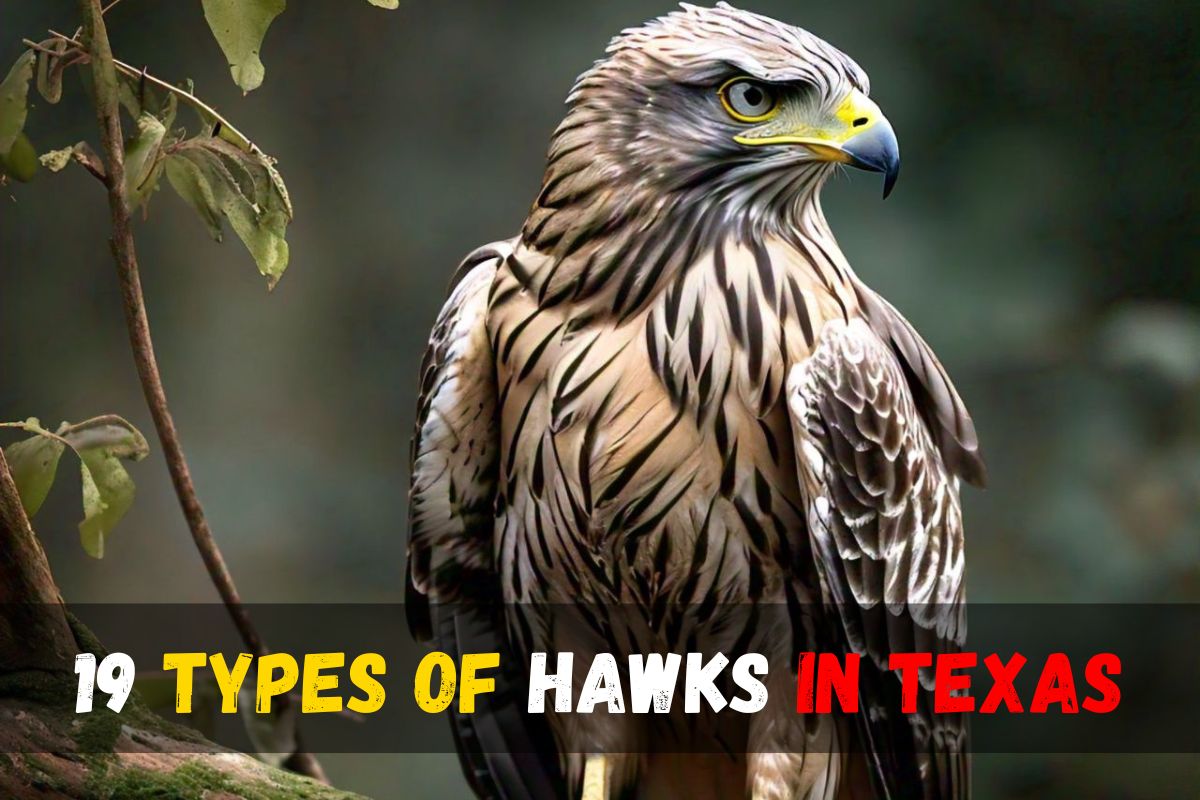Texas is home to a diverse array of wildlife, and its expansive landscapes provide habitat for various bird species, including hawks. Hawks are birds of prey known for their keen eyesight, powerful talons, and impressive hunting abilities. In Texas, you can find a variety of hawk species, each adapted to different ecosystems within the state.
Texas, as the biggest state in the continental United States, boasts a rich avian tapestry, particularly in its role as a pivotal point along the migratory routes of numerous bird species, including the majestic hawk. The state’s expansive dimensions, covering 268,820 square miles, and its geographical proximity to Mexico create an ideal intersection for diverse habitats, contributing to an impressive roster of avifauna. The ornithological allure of Texas extends beyond sheer size, encompassing a remarkable bird list comprising 670 species.
19 Types of hawks in Texas
Red-shouldered Hawk
Identification
The Red-Shouldered Hawk, scientifically known as Buteo lineatus, is a captivating medium-sized bird of prey native to Texas. Recognizing this species involves noting its distinctive features: medium size, reddish-orange underparts and shoulders, black and white checkered wings, and a white-banded tail. Its loud, jay-like calls, a distinctive “keer keer keer,” further aid in identification.
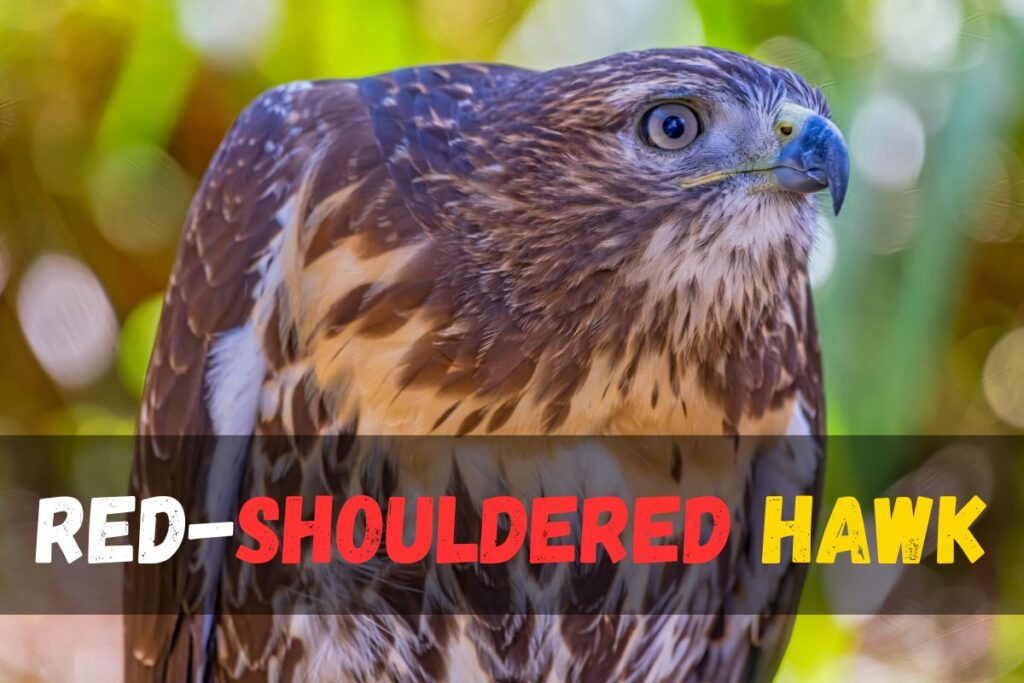
Location
These hawks are prevalent throughout Texas, particularly in woodlands, mixed woodlands, and forested areas. They show a preference for habitats near water sources like ponds, lakes, or streams. During winter, their numbers increase as individuals from the Northern States migrate to Texas for warmer temperatures.
Appearance
Measuring around 22 inches in length with an average wingspan of 40 inches, Red-Shouldered Hawks exhibit a stunning blend of red and brown streaks on their wings. Their rust-red colored shoulders and black and white checkered wings make them visually striking. These hawks are medium-sized, showcasing remarkable agility as they navigate through trees in pursuit of prey.
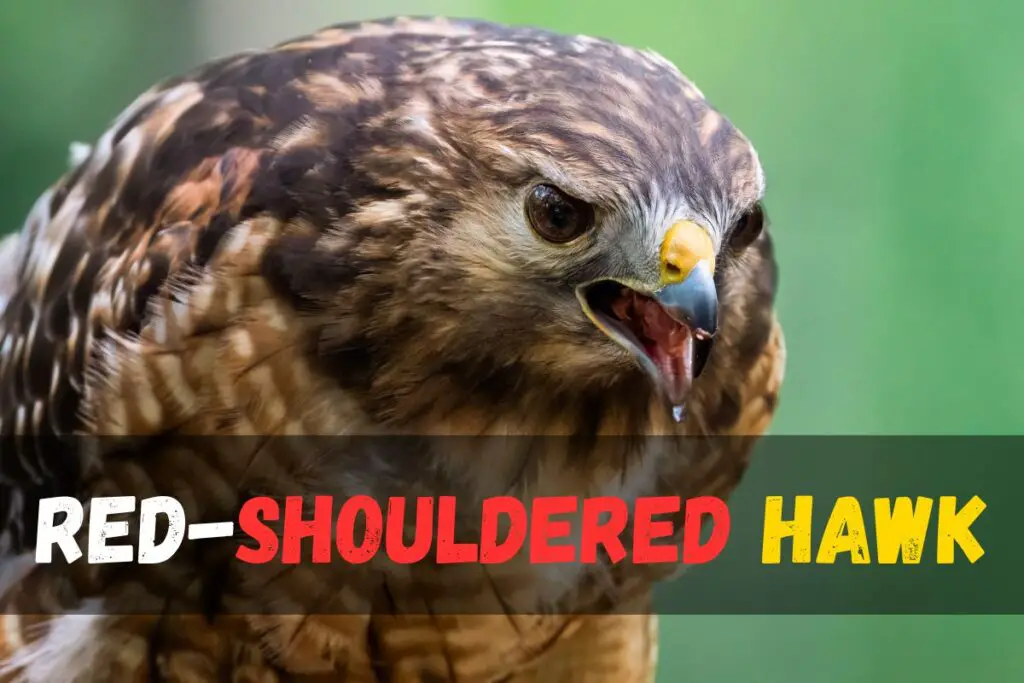
Habitat
Red-Shouldered Hawks are year-round residents in Texas, with a stronghold in woodlands and forests. They strategically place their nests at the top of broad-leaved trees, demonstrating a preference for areas near water bodies. During the breeding season, they reuse the same nest, making minor structural adjustments.
Diet
These hawks have a diverse diet, preying on snakes, frogs, small mammals, and occasionally other birds. Their foraging strategy involves perching and then swooping down to catch prey on the ground. The red-shouldered hawk’s adaptability to different prey items contributes to its successful survival.
Population
The Red-Shouldered Hawk population in Texas is robust, with an estimated 1.9 million individuals. This species is of low concern, experiencing an annual population increase of approximately 2%. The primary threat, however, lies in habitat destruction and clearing, emphasizing the importance of conservation efforts to ensure their continued thriving presence.
Red-tailed Hawk
Identification:
The Red-Tailed Hawk, scientifically known as Buteo jamaicensis, stands out as one of the most recognizable and common hawks in Texas and North America. Identified by its large size, distinctive red tail feathers, and a characteristic call that resembles a rough kee-eeee-arr, this majestic bird of prey is a year-round resident in Texas, making it a frequent sight for bird enthusiasts and casual observers alike.

Where to Look for Them:
To catch a glimpse of the Red-Tailed Hawk, one should focus on open fields along highways, where they are often spotted circling high above. Their broad wings and keen vision make them adept at scanning the area below for potential prey. Additionally, these hawks can be observed perched on telephone wires or treetops, patiently waiting for their next meal to appear.
Appearance:
The Red-Tailed Hawk boasts a striking appearance with brown upperparts, white underparts, and a unique rust-red colored tail that is short and wide. Their wingspan ranges from 44.9 to 52.4 inches, making them one of the largest hawk species in the United States. Juveniles may have brown tails with dark barring, while adults exhibit a broad reddish tail. The species is sexually dimorphic, with females being larger than males.
Habitat:
This adaptable bird of prey thrives in various environments, from mixed woodlands, where they nest high in the canopy of trees, to cliff ledges and even tall buildings. Red-Tailed Hawks have a wide range, covering Alaska and the USA, parts of Canada, Mexico, the Caribbean, and portions of Central America. Their versatility in choosing habitats contributes to their high population and “Least Concern” conservation status.
Diet:
Red-Tailed Hawks exhibit a diverse diet, preying on small mammals such as squirrels and rats, snakes, and birds. They employ a hunting technique that involves swooping down from a perch or during a soaring flight to catch their prey. Their powerful talons and impressive speed make them efficient hunters, showcasing their role as top predators in their ecosystems.

Population:
The Red-Tailed Hawk maintains a robust population, in part due to its adaptability and wide distribution. While they are year-round residents in Texas, some individuals migrate from North America to Texas during the winter months. Their ability to thrive in different habitats and their hunting prowess contribute to their sustained numbers.
Harris’s Hawk
Introduction:
Harris’s Hawk, scientifically known as Parabuteo unicinctus, is a fascinating species known for its distinctive hunting behavior. Unlike most hawks, Harris’s Hawks exhibit a unique trait of hunting in packs, showcasing a remarkable level of intelligence and tolerance for group dynamics.
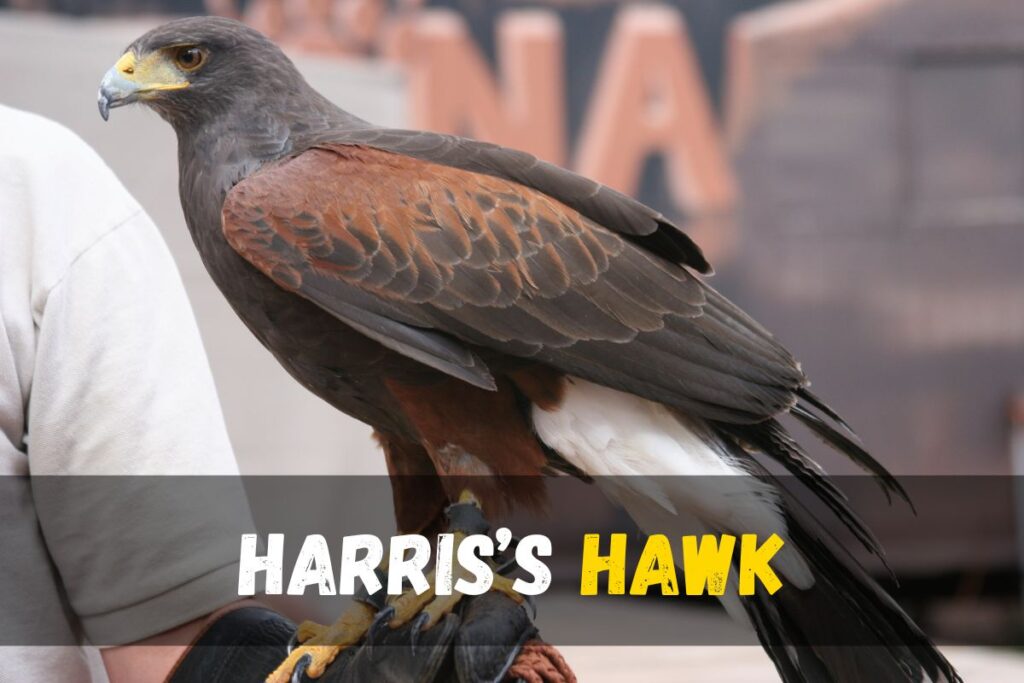
Appearance:
Identified by its large, dark brown and reddish-brown plumage, Harris’s Hawk features a long black and white tail and yellow accents on the base of its beak. Notably, both males and females share a similar appearance, with females being slightly larger.
Habitat and Distribution:
These social raptors are found in desert and subtropical habitats, ranging from Texas and parts of the southwestern USA south to Argentina. In Texas, especially in southern and central regions, Harris’s Hawks are prevalent. They thrive in desert lowlands with ample high perches for various activities, including perching, feeding, and nesting.
Behavior and Social Structure:
One of the most remarkable aspects of Harris’s Hawks is their inclination to hunt in groups of up to seven birds. This social behavior is uncommon among raptors and contributes to their distinction as the most social raptors in North America. It’s believed that the size of the group correlates with the hawk’s lifespan, indicating a fascinating aspect of their cooperative hunting strategy.
Diet:
Their diet comprises a diverse range of medium-sized mammals, reptiles, and birds. The hunting technique involves swooping down from a perch or low flight to catch prey. Rabbits and other small animals and birds are among their preferred targets.
Reproduction:
Harris’s Hawks exhibit a unique breeding pattern, with up to three clutches of eggs per year. Surprisingly, they have been reported breeding in every month of the year, showcasing a lack of strict breeding guidelines. The nesting sites include large cacti or sturdy structures, where they build bulky stick nests using a variety of materials.
Subspecies and Conservation Status:
The species has three distinct subspecies: P. u. harrisi, P. u. Superior, and P. u. Unicinctus. Recognizing the scientific name becomes crucial when discussing different types of hawks to avoid confusion. Fortunately, Harris’s Hawk holds a “Least Concern” status, indicating a stable population in its natural habitats.
Sharp-shinned Hawk
Introduction:
Sharp-Shinned Hawks, scientifically known as Accipiter striatus, are captivating raptors that grace Texas with their presence, particularly during the winter months. These hawks, often mistaken for their doppelganger, the Cooper’s Hawk, possess distinct characteristics that set them apart.

Identification:
The identification of Sharp-Shinned Hawks involves attention to specific details. These small to medium-sized hawks exhibit a blue-gray upperpart, with a unique rust-orange breast that fades towards the belly. Notably, females are larger than males, showcasing a size difference of around 13 inches for females and 9 inches for males. Their wingspan varies accordingly, with females having an average wingspan of 22 inches compared to the male’s 16 inches.

In flight, these hawks display rounded wings and a long, rectangular tail, distinguishing them from their avian counterparts. Their calls, often described as falcon-like repeated ringing – “kew kew kew kew kew kew kew kew,” further aid in identification.
Where to Look for Them:
To catch a glimpse of Sharp-Shinned Hawks in Texas, focus on areas that align with their preferred habitats. These adept hunters navigate through dense woodlands, often seen along the edges of forests. Prime birding sites include the Aransas National Wildlife Refuge and Anahuac National Wildlife Refuge.
Additionally, during winter, these hawks may venture beyond their typical forest habitats, occasionally visiting suburban areas and even backyard bird feeders. Observing their acrobatic flight near feeders is not uncommon.
Appearance:
Sharp-shinned Hawks exhibit an athletic and acrobatic demeanor. Their small size, distinctive blue-gray upperparts, and orange-barred breasts make them stand out. During flight, their heads do not protrude as much as Cooper’s Hawks, and their square-tipped tails are noteworthy. Females, being larger, also showcase thick brown streaks on pale underparts.
Habitat:
These hawks are versatile in their habitat selection, residing in wooded areas across Alaska, Canada, the USA, Mexico, parts of Central America, the Caribbean, and even parts of South America. In Texas, they are commonly found in forest edges and suburban regions.
Diet:
Sharp-Shinned Hawks are avid bird hunters, with a diet primarily consisting of songbirds like warblers, sparrows, thrushes, and robins. They occasionally target larger birds such as woodpeckers, doves, and swifts. Insects and small mammals like mice and voles also make it to their menu.
Population:
The population of Sharp-Shinned Hawks is estimated to be around 1 million breeding individuals, and they are classified as “Least Concern.” Despite threats like pesticides, shooting, and hunting, their population remains stable. Conservation efforts, particularly against pesticide exposure, play a crucial role in ensuring the well-being of this species.
Cooper’s Hawk
Identification
Cooper’s Hawks, often confused with the Sharp-Shinned Hawk, are medium-sized birds of prey known for their distinctive features. They possess broad wings, a long tail, and a blocky, square-shaped head. Adult Cooper’s Hawks exhibit blue-gray upperparts, a rust-red underpart with orange barring, and a dark-banded tail. They can be identified by their unique call, described as a short cak-cak.
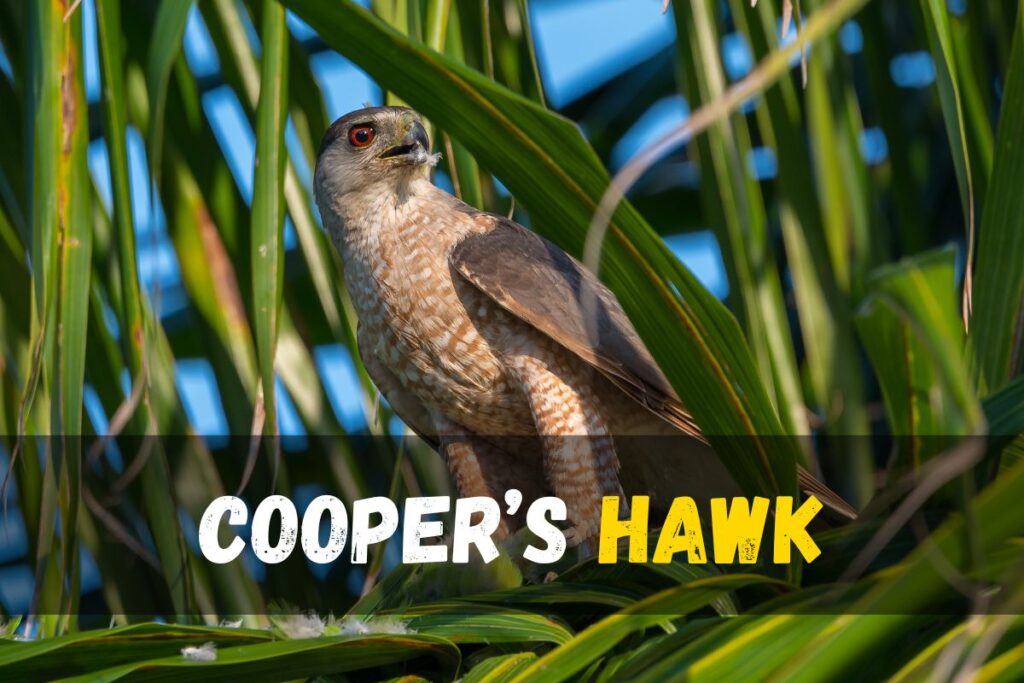
Where to Look for Them
In Texas, Cooper’s Hawks are commonly found in forests, particularly along the edges where they soar in pursuit of prey. These versatile birds are also known to frequent urban areas, backyards, and bird feeders. During winter, their population increases as migratory birds from northern states and Canada head south to Texas, making them more visible in this region from September to March.
Appearance
Male and female Cooper’s Hawks exhibit slight differences in size. Females are larger, measuring around 16 inches in length, while males are slightly smaller. Both sexes share a characteristic blue-gray back, red-orange breast, and dark bands on the tail. Young Cooper’s Hawks are dark brown above with fine streaking on pale underparts.
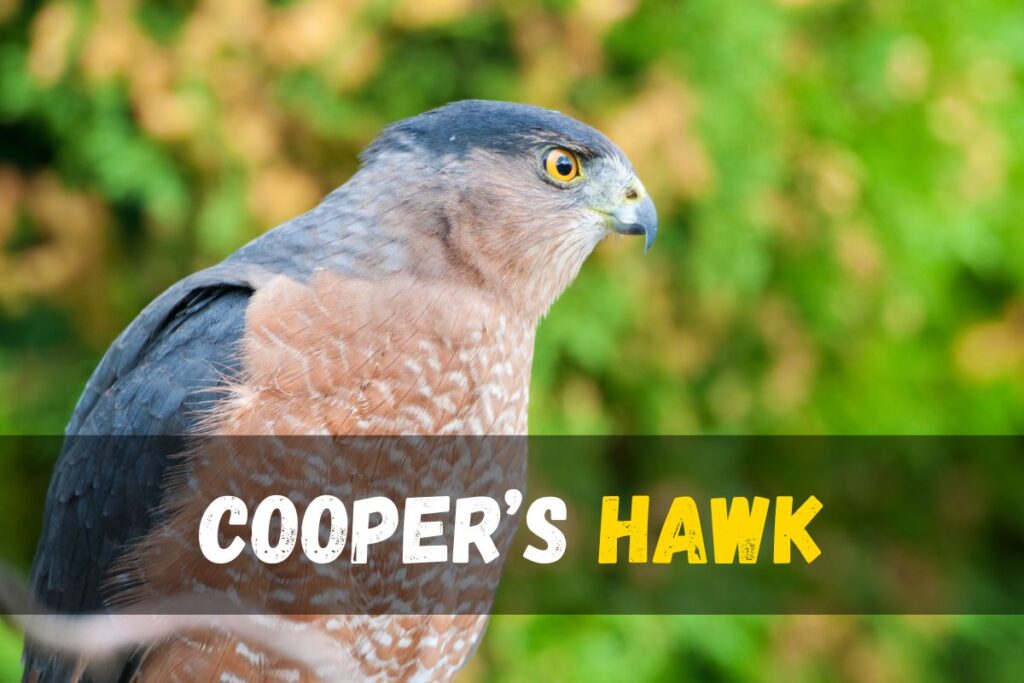
Habitat
Cooper’s Hawks are adaptable to various wooded and semi-wooded habitats, ranging from southern Canada through most of the USA to parts of Mexico. They often build their nests in tall trees, mistletoe clusters, or on abandoned nests. The nest is constructed with sticks, and green twigs and bark pieces are used for lining.
Diet
These hawks primarily prey on small birds, including doves and medium-sized songbirds, and small mammals like voles and mice. They are notorious for stalking bird feeders, making them a common sight in suburban areas. If you notice a Cooper’s Hawk in your backyard, temporarily removing bird feeders can encourage them to move on.
Population
Cooper’s Hawks are a resilient species. In the past, their population faced declines due to the pesticide DDT, but since the 1950s and 60s, they have rebounded, and their status is currently listed as “Least Concern.” They are the fourth most frequently spotted hawks in Texas, with higher sightings during the winter months.
White-tailed Hawk
Identification
The White-Tailed Hawk, scientifically known as Geranoaetus albicaudatus, is a distinctive large hawk found primarily in South America and the southernmost parts of Texas in North America. Its identification features include light-blue-grey coloring on top, white underparts, red shoulders, and a tail adorned with white feathers and dark brown markings.
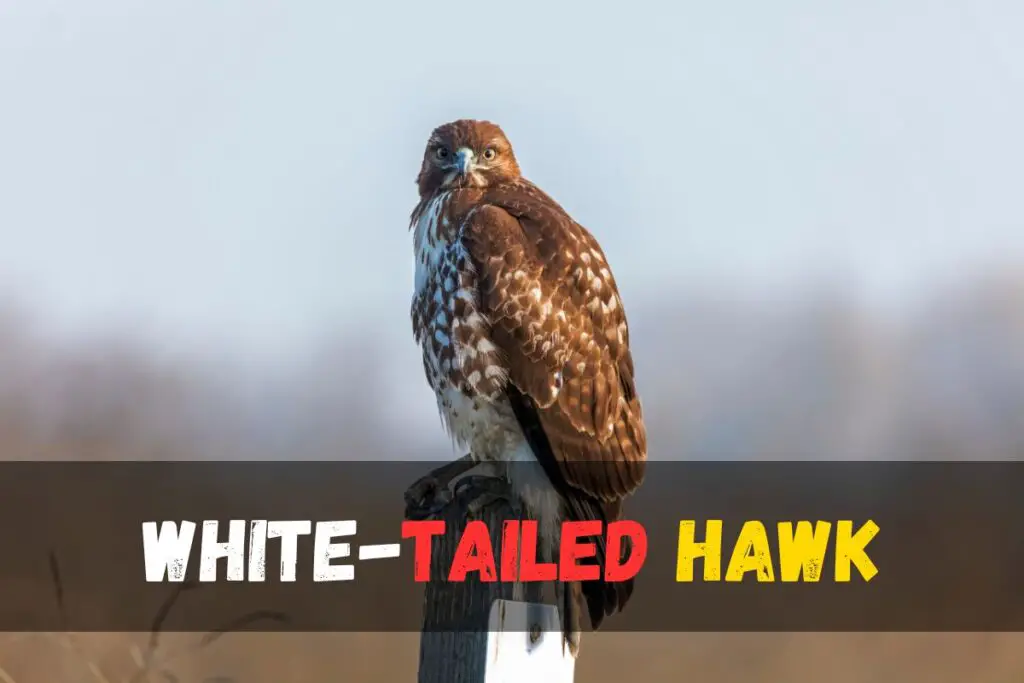
Where to Look for Them
In Texas, White-Tailed Hawks are commonly spotted in open areas, including savannahs, grasslands, and pastures. Notably, the Laguna Atascosa National Wildlife Refuge and Aransas National Wildlife Refuge are excellent locations for observing this species. Their presence is consistent throughout the year, with a higher frequency of sightings recorded between October and April.
Appearance and Size
Adult White-Tailed Hawks exhibit a hooded appearance with dark gray upperparts, rufous shoulders, and a white lower back. Females are slightly larger than males, measuring around 22 inches in length, with both sexes having an average wingspan of 50 inches. Juveniles, initially dark gray or blackish, develop distinctive speckling across their underparts, fading with age.
Habitat
These hawks prefer habitats such as open savannahs, prairies, grasslands, and tropical savannahs from Mexico to Argentina, extending into southern Texas. They build loose, flat stick nests in low trees within grassy areas.
Diet
White-Tailed Hawks are opportunistic hunters with a varied diet, including mammals like rabbits, rats, and mice, as well as reptiles, smaller songbirds, crustaceans, large insects, and carrion. Their hunting techniques may involve low-level flights, particularly after a fire to capture fleeing animals.
Population Status
The White-Tailed Hawk is categorized as “Least Concern,” with an estimated global population of around 2 million breeding individuals. However, this species faces threats from human disturbance and habitat loss.
Ferruginous Hawk
Identification
The Ferruginous Hawk, scientifically known as Buteo regalis, is a distinctive species of hawk identified by its large size, unique plumage, and notable features. Recognized as the largest hawk species in Texas, they exhibit two color morphs: a more common light morph with white underparts and rusty brown upperparts, and a rarer dark morph characterized by dark brown coloration with a pale tail and flight feathers.

Where to Look for Them:
Ferruginous Hawks can be found primarily in the open plains and grasslands of Texas, especially during the winter months from November to February. Their presence is notable in wide, low-country grasslands and shrublands, but they do not cross the Rockies, even during migration. Nesting sites are often solitary trees, rock outcroppings, or other isolated structures.
Appearance and Habitat:
These impressive raptors are eagle-like, boasting long wings, a pale tail, and feathered legs, a unique characteristic shared by only a few hawk species. The term “ferruginous” derives from their rust-colored plumage on the back and legs. They have large heads, measuring up to 23 inches in length, with a wingspan of 55 inches. Their nests are substantial, measuring 3 feet high and 3 feet across.

Diet:
Ferruginous Hawks are daytime hunters, preying on small mammals like jackrabbits, cottontail rabbits, ground squirrels, and prairie dogs. They display impressive hunting techniques, capturing prey either on the wing or by perching, and sometimes even on the ground. Waterfowl can also be on their menu, showcasing their adaptability in hunting strategies.
Population Status:
Regrettably, Ferruginous Hawks face an endangered status with only an estimated 4,000 breeding pairs remaining in the wild. Unlike many other hawk species enjoying thriving populations, the Ferruginous Hawk’s limited distribution and habitat preferences contribute to its vulnerable status. Conservation efforts are crucial to ensuring the survival of this unique and majestic hawk species.
Grey Hawk
Identification
The Grey Hawk, scientifically known as Buteo plagiatus, is a distinctive medium-sized raptor found in Texas. Identified by its unique features, it has short, round wings, a long tail, and grey plumage throughout its body. The head is slightly paler in grey, and the chest exhibits fine barring. Notably, the tail is adorned with distinct black and white bands, making it easily recognizable in its habitat.

Where to Look Them
Grey Hawks can be found in specific habitats within Texas. They are most frequently observed in thorny scrub, riverside woodlands, and forest edges, particularly near willows and cottonwoods. Notable locations for spotting these fascinating birds include Big Bend National Park and Santa Ana National Wildlife Refuge.
Appearance and Habitat:
The Grey Hawk boasts a wingspan ranging from 18.1 to 24 inches (46 to 61 cm) and an average weight of 16.8 ounces (475 g). Their nests are commonly situated near the tops of cottonwood trees on outer branches, close to rivers. Additionally, they choose oak, willow, ash, and walnut trees for nesting. The nests are constructed with leafy twigs and lined with leaves, predominantly from cottonwood and willow trees, along with bark pieces.
Diet and Feeding Habits:
These hawks predominantly feed on reptiles, with a menu consisting of horned lizards, spiny lizards, tree lizards, whip snakes, and garter snakes. While reptiles form the primary part of their diet, Grey Hawks also occasionally consume birds, small mammals, amphibians, and insects. Their feeding preferences reflect a specialization in hunting and consuming various prey within their chosen habitats.
Population and Conservation Status:
The Grey Hawk, fortunately, is classified as “Least Concern” in terms of conservation status. With a global population of approximately 2 million breeding birds and an increasing trend, these raptors are not currently under significant threat. However, it is essential to note that habitat destruction and groundwater depletion pose potential risks to their continued well-being.
In Texas, the Grey Hawk has a limited but reasonably common presence. The population is most frequently observed during the summer, with some individuals remaining in the region throughout the year. The conservation efforts in Texas, especially in protected areas like Big Bend National Park and Santa Ana National Wildlife Refuge, contribute to the positive trend in their population.
Zone-tailed Hawk
Identification:
The Zone-Tailed Hawk, scientifically known as Buteo albonotatus, is a distinctive medium-sized bird of prey found in Texas. Its identification is marked by a blackish-grey overall body, broad wings, and a white band on its tail. Often mistaken for Turkey Vultures due to its gray-black plumage and large size, the Zone-Tailed Hawk can be differentiated by its dark brown upperparts and unique two-toned color on the underside of its wings.

Where to Look for Them:
These hawks are uncommon in Texas but can be spotted in the southern and western regions, especially in dry areas such as scrub, deserts, and coastal regions. They are known to nest in cottonwoods, willows, oaks, and pines along rivers. Look for them soaring along cliff edges and over canyons in search of prey. Prime locations include Big Bend National Park and Bentsen-Rio Grande Valley State Park.
Appearance:
With an average length of around 20 inches and a wingspan of 52 inches, the Zone-Tailed Hawk exhibits a unique dark brown upper part and distinctive white barring across the breast, under the wings, and tail. Their wings have dark trailing edges, and the underwings display fine barring.

Habitat:
These hawks have a diverse habitat preference, ranging from grasslands, desert scrub, arid foothills, to canyons, cliffs, and coniferous forest edges. They are also known to migrate to Mexico during wintertime, although some may remain in Texas if temperatures are high.
Diet:
The primary food source for Zone-Tailed Hawks includes small mammals, although they also prey on amphibians, reptiles, and smaller birds for their diet. Their unique hunting technique involves using the surrounding landscape as a screen, flying close to the ground, and snatching up their prey with expert precision.
Population:
Currently listed as “Least Concern,” the Zone-Tailed Hawk has an estimated 2 million breeding individuals. Their population trend is on the rise, and they are expanding their range further into the United States. Threats to their population include habitat destruction, modification, and shooting. Conservation efforts should focus on preserving their nesting and foraging areas.
Swainson’s Hawk
Identification
Swainson’s Hawks, scientifically known as Buteo swainsoni, are medium- to large-sized hawks commonly found in Texas during the summer months. These birds are easily identifiable by their distinct characteristics. With a wingspan ranging from 46 to 54 inches, they exhibit a unique pattern in flight – the underside and tips of their wings contrast from black to white, making them distinguishable against the Texas skies. Additionally, their brown-gray, mottled upperparts, rust-red breast, and lighter underparts contribute to their unmistakable appearance.

Where to Look for Them
To observe Swainson’s Hawks in Texas, the open countryside is the ideal setting. They are often spotted along roadsides as they search for prey. However, their nesting habits might lead them to utilize various locations, including low bushes, singular trees, and even telephone poles. Birding enthusiasts frequently find them in specific locations such as Brazos Bend State Park and Lost Maples State Natural Area.
Appearance
Swainson’s Hawks in Texas showcase variability in plumage, particularly in reddish-brown chests, whitish bellies, and brownish-grey uppersides. Males and females are similar, with the only noticeable distinction in the color of their heads – grey for males and brown for females. During flight, the dark flight feathers against pale coverts on the underwing provide a striking visual contrast.

Habitat
These hawks prefer open areas such as grasslands, prairies, and agricultural land. While they are commonly found in Texas during the summer, they breed in grasslands, meadows, and open habitats in central and western Canada and the USA. Their nests, built from sticks and lined with softer materials like wool and grass, can be as large as 2 feet wide and a foot high.
Diet
Swainson’s Hawks are opportunistic eaters, adapting their diet to the region they inhabit. During the breeding season, they primarily feed on mammals such as mice, rabbits, bats, ground squirrels, gophers, and voles. In the non-breeding season, their diet shifts predominantly to insects, including butterflies, moths, grasshoppers, beetles, crickets, and dragonflies. They are also known to hunt for Burrowing Owls and exhibit a varied diet that encompasses snakes, lizards, and other birds.
Population
Fortunately, Swainson’s Hawks are not a species of conservation concern. Their population has shown an increasing trend over the past several decades, with an estimated breeding population of around 900,000 individuals. The species has adapted well to the diverse habitats available throughout its migration path, from Texas to southern South America.
Broad-winged Hawk
Identification
Broad-winged hawks, scientifically known as Buteo platypterus, are small to medium-sized birds found exclusively in Texas during the summer months, from April to August. These hawks boast a distinct appearance, making them easily identifiable. Their key features include broad wings, dark brown plumage on the upper parts, and brown-barred white plumage underneath. The broad wingspan ranges from 31.9 to 39.4 inches, and they emit a distinctive kee-eee whistled call.

Where to Look for them
If you’re eager to catch a glimpse of Broad-Winged Hawks, focus your observations in mixed woodlands and dense forests, particularly during the breeding season. The eastern half of Texas serves as their migration range, with breeding locations in the eastern regions, including Houston north to the border. Notably, they can be spotted in large cities such as San Antonio and Austin during migration.
Appearance and Habitat
The Broad-Winged Hawk’s appearance is characterized by brown heads and upper parts, barred brown undersides, pale underwings with a dark outline, and prominently banded tails. They prefer nesting in forests close to water bodies, constructing their nests against tree trunks or low branches. These nests, made of sticks and lined with moss, feathers, pine needles, and lichen, are strategically placed for raising their chicks.
Diet and Hunting Habits
These hawks are skilled hunters, often perching on the edges of woods or water to spot their prey. Their diet includes small mammals, frogs, snakes, and even young turtles. While hunting, they exhibit a preference for reusing the nests of other animals, like crows or squirrels, adding a few reinforcements and relining them with soft materials.
Population and Conservation Status
The Broad-Winged Hawk is categorized as “Least Concern” in terms of conservation status, indicating a healthy and increasing population trend. The breeding population comprises approximately 1.9 million individuals. However, habitat loss, destruction, human disturbance, and hunting pose potential threats to this species.
Northern Goshawk
Identification
The Northern Goshawk, scientifically known as Accipiter gentilis, is an impressive species of hawk found in Texas. Identified by its large size, the Northern Goshawk boasts a wingspan ranging from 40.5 to 46.1 inches and a length of about 25 inches. Its distinguishing features include black and gray striped feathers covering most of its body, complemented by a noticeable white stripe horizontally above each eye. The bird produces a distinct ki-ki-ki call, making it recognizable in its habitat.

Where to Look for them
While the Northern Goshawk is not a common sight in Texas, especially during winter when it only occurs in the northern part near Amarillo, enthusiasts may catch a glimpse of this magnificent bird in its preferred habitat. These elusive creatures inhabit mature and old-growth forests, particularly those with openings in the canopy. The challenging aspect lies in their territorial nature, making it essential to exercise caution and maintain a respectful distance from their nests.
Appearance and Habitat
The Northern Goshawk exhibits a slate-grey upper body, finely barred grey bellies, and a distinctive red eye. Their preferred nesting spots are tall trees with openings in the canopy, where they construct nests using sticks and line them with bark pieces and green plant material. The species tends to take over abandoned nests built by other birds. These hawks are known for their territorial behavior, and they have been observed attacking humans who venture too close to their nests.

Diet and Feeding Behavior
Northern Goshawks are opportunistic eaters, preying on a diverse range of animals. Their diet includes mammals such as cottontails, ground squirrels, hares, and jackrabbits, as well as large birds like crows, jays, woodpeckers, and grouse. With a preference for perching high up in tall tree branches, they utilize their exceptional eyesight to spot small mammals and birds on the ground. Their feeding behavior involves swift maneuvers through trees, showcasing their agility in capturing prey.
Population Status and Threats
Despite their scarcity in Texas, the Northern Goshawk is classified as a species of least concern with a stable population estimated at around 420,000 breeding individuals. However, these majestic birds face threats such as hunting, shooting, and habitat destruction, particularly from logging activities. Poultry farmers, perceiving them as a threat to livestock, contribute to the challenges faced by this species. Conservation efforts are crucial to ensuring the continued stability of the Northern Goshawk population.
Rough-legged Hawk
Identification
Rough-Legged Hawks, scientifically known as Buteo lagopus, are distinctive birds of prey found in Texas during the winter months. They belong to the family of hawks and are renowned for their unique feathered legs, a feature shared only with Ferruginous Hawks. These birds exhibit two morphs, light and dark, with variations in coloration and patterns.

Where to Look for Them
The Rough-Legged Hawk is an uncommon winter visitor to Texas, primarily seen in the state’s northern regions. Ideal locations for spotting these hawks include prairies, fields, dunes, semideserts, marshes, bogs, and shrubsteppe habitats. Notable sites for observation are Lake Rita Blanca and areas around Lubbock.
Appearance and Size
These large birds of prey boast a wingspan ranging from 52 to 54.3 inches and a length of approximately 20 inches. Their long wings, black and white tail, and distinctive feathered legs make them easily identifiable. Depending on the morph, they may have light or dark coloration, with variations in patterns and markings.
Habitat
During winter, Rough-Legged Hawks migrate south to Texas, seeking open fields for hunting. They prefer weedy fields and other open habitats for soaring and hunting rodents like mice, ground squirrels, and voles. Although they typically build nests on cliff edges, man-made structures or trees may also serve as nesting sites.
Diet
The primary diet of Rough-Legged Hawks consists of lemmings in their Arctic breeding grounds. In Texas, during their winter stay, they focus on consuming rodents such as mice, ground squirrels, and voles. Their hunting style involves soaring and hovering over open fields.
Population and Conservation
Rough-Legged Hawks are not of conservation concern, with a stable breeding population of approximately 590,000 individuals. However, their population size can vary based on food availability and climatic conditions in different regions. Threats include car strikes and habitat destruction.
Northern Harrier
Identification:
The Northern Harrier, scientifically known as Circus hudsonius, is a distinctive and unique hawk species. It can be easily identified by its long wings, long tail, and white rump. Adult males exhibit gray upperparts, head, and breast, while females have brown upper parts and pale underparts with brown streaks. Notably, both sexes share a white rump, and young birds are distinguished by deep orange-buff underparts.
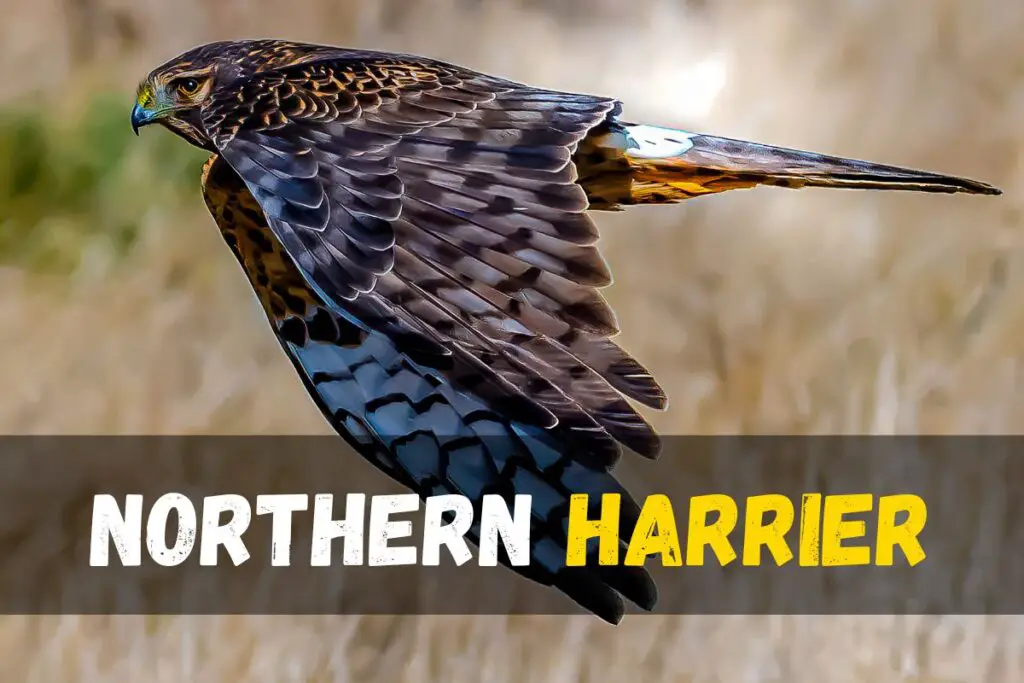
Where to Look for Them:
While not a common sight in Texas due to its preference for milder climates, the Northern Harrier can be spotted during winter months when it migrates. Look for them in grasslands and marshes, especially during their pursuit of small birds and mammals. They may also be observed in the northern regions of the country.
Appearance:
This long-tailed hawk has a wingspan of around 43 inches, measuring about 19 inches in length. Its plumage varies, with males having gray upperparts and females exhibiting brown upper parts. A distinctive feature is the white patch on the rump present in both sexes. During flight, the Northern Harrier carries its wings higher than its body, forming a V-shape, making it visually distinguishable.
Habitat:
The Northern Harrier prefers open grasslands, wetlands, and marshes for breeding and hunting. They construct nests on the ground using materials like reeds, willows, and brushtails. Breeding grounds include Alaska, Canada, California, and parts of the USA, while winter habitats extend from the USA and Mexico to northern South America.
Diet:
With a diet mainly comprising small mammals and birds, Northern Harriers exhibit predatory behavior, often seen gliding low over marshes and grasslands during pursuit. Their nests, built close to the ground in dense vegetation, provide safety for raising their clutch of 4-5 dull white eggs.
Population:
The Northern Harrier is categorized as “Least Concern” in terms of conservation status. Although not as commonly seen in Texas, their population thrives in various habitats, including breeding grounds in Alaska, Canada, and the northern USA. Migration patterns contribute to their presence in different regions during specific seasons.
Common Black Hawk
Identification:
The Common Black Hawk (Scientific name: Buteogallus anthracinus) is a distinctive raptor found in the far western regions of Texas. Identified by its large size, broad wings, and short, white-banded tail, this bird stands out with its jet-black plumage. Notably, it is often confused with the Great Black Hawk, but certain features, such as the white band on its tail, help differentiate the two.

Where to Look for Them:
If you’re an avid birdwatcher or nature enthusiast in Texas, the Common Black Hawk is a rare but fascinating sight. While still considered uncommon, these hawks are primarily spotted in the southern part of the state, particularly in the Davis Mountains and Big Bend National Park. During the summer breeding season, they migrate to the western parts of Texas.
Appearance:
Recognizable by its bulky build and short, broad tail with a distinctive white band and narrow tip, the Common Black Hawk boasts a wingspan averaging 46.1 inches. Both males and females share similar appearances, with females being slightly larger. Young birds have dark brown markings and a buff face, making them distinguishable from adults.
Habitat:
These raptors inhabit diverse ecosystems, including riparian forests, mangroves, swamps, marshes, canyon bottoms, and deserts. Known for building nests in large trees along rivers, they prefer areas with water sources. Threats to their habitat include agricultural practices affecting water tables, overgrazing, and invasive plant species.
Diet:
Common Black Hawks are versatile predators, feeding on fish, small mammals, reptiles, and insects. Their diet includes wasps, grasshoppers, waterbugs, centipedes, ants, butterflies, crayfish, clams, frogs, lizards, snakes, and rabbits. Interestingly, they rarely prey on birds, showcasing a diverse feeding behavior.
Population:
Despite being a rare species in Texas, the Common Black Hawk is not of immediate conservation concern due to its extensive range. The estimated breeding population is around 2 million individuals. However, threats such as changes in water availability and habitat disruption from human activities highlight the importance of conservation efforts.
Migration Patterns:
Come fall, Common Black Hawks take to the skies, migrating back to their native Central America and Mexico. This migratory behavior adds a dynamic aspect to their presence in the Texan landscape, emphasizing the seasonal nature of their stay.
Osprey
Identification
Ospreys, scientifically classified under the Family Pandionidae and Genus Pandion, distinguish themselves from other birds of prey in Texas. It’s crucial to emphasize that despite their hawk-like appearance, they are not hawks nor eagles. This distinct classification sets them apart, making Ospreys a unique and fascinating species.

Appearance and Misconceptions
At first glance, Ospreys might be mistaken for hawks due to their striking resemblance. Commonly referred to as Sea Hawk, River Hawk, or Fish Hawk, their appearance often leads observers to believe they are a type of hawk. However, this misconception underlines the need for proper identification.

Where to Find Ospreys in Texas
While Ospreys aren’t typical members of the hawk family, they share habitats and behaviors with these birds. To spot Ospreys in Texas, one should focus on areas around bodies of water, as these birds are intricately tied to aquatic environments. Their preference for water bodies is linked to their diet, making these locations ideal for nesting, breeding, and raising their young.
Habitat and Nesting Behavior
Ospreys exhibit a fascinating behavior of mating for life, often utilizing human-made nesting platforms near large bodies of water. This behavior ensures a stable environment for their offspring. For individuals living near such water bodies, installing nesting platforms can attract Osprey pairs, providing a unique opportunity to observe their nesting habits.
Diet and Hunting Techniques
A critical aspect of Osprey’s behavior revolves around their specialized diet. Approximately 99% of their diet consists of fish. Their distinctive talons, uniquely adapted for catching slippery fish, showcase an impressive design. Ospreys don’t merely skim the water’s surface; instead, they plunge into the water with force, emerging with their catch. This remarkable hunting technique sets them apart from eagles and other birds of prey.
Population and Conservation
While not as widely recognized as hawks, Ospreys play a vital role in the ecosystem. Understanding their population dynamics is crucial for conservation efforts. Despite their unique characteristics, Ospreys face challenges, and monitoring their population helps in implementing effective conservation strategies.
Roadside Hawk
Introduction:
Roadside Hawks, an accidental species in Texas, bring a unique charm to the avian diversity of the state. Although uncommon, these birds have left an indelible mark, with sporadic sightings primarily in the extreme south of Texas, notably in the Bentsen-Rio Grande Valley State Park.
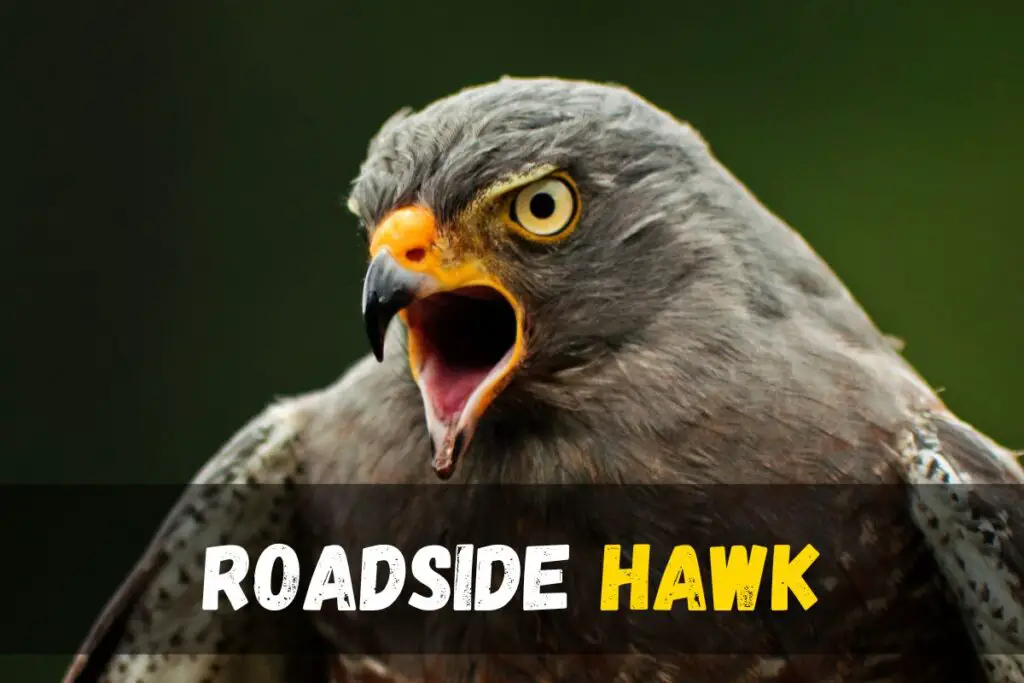
Identification:
Recognizing a Roadside Hawk in Texas is a fascinating task. Distinguished by their small size, brown or gray plumage, and barred bellies, these hawks possess tails adorned with five gray bars. The name “Roadside Hawk” is derived from their affinity for perching on telephone poles and tall fences along the roadsides.
Where to Look for Them:
To catch a glimpse of these fascinating birds, keep a keen eye on the extreme south of Texas. The Bentsen-Rio Grande Valley State Park, where the last recorded sighting occurred in 2018, serves as a hotspot for their appearances. Perched on elevated vantage points like telephone poles, they scan the surroundings for prey.
Appearance:
The distinctive features of Roadside Hawks include gray upperparts, an orange and white barred underside, and striking black and orange wing markings. With a length of around 14 inches, these hawks boast a bright yellow eye and a formidable bright yellow beak, adding to their captivating appearance.
Habitat:
While little is known about their preferred habitat in Texas, observations suggest a correlation between their diet and habitat comfort. Dry areas such as deserts and scrubs seem to be the preferred domains of the Roadside Hawk. Beyond Texas, their usual haunts encompass South America, Central America, and Mexico.
Diet:
These hawks are skilled hunters, preying on small mammals, lizards, and insects. Their modus operandi involves perching on wires and posts, from where they execute rapid descents, deploying razor-sharp talons to secure their prey instantly.
Population:
Roadside Hawks, though primarily residents of Mexico, Central America, and South America, occasionally venture as far as the Southern US states. Their population in Texas is relatively sparse, contributing to their status as an “accidental” species in the region.
Short-tailed Hawk
Identification:
Short-Tailed Hawks, scientifically known as Buteo brachyurus, are a distinctive species found in Texas. These small soaring raptors exhibit two color morphs: light and dark. The light morph features white underparts and a light brown back, while the dark morph is covered entirely in dark brown feathers, except for a few lighter brown flight feathers. Both types share a characteristic short tail, which, despite its name, is relative to other hawk species.

Where to Look for Them:
While considered an accidental species in Texas, Short-Tailed Hawks have been recorded in the state, with sightings documented in 2021. These birds are rare vagrants to southern Texas. To catch a glimpse, keep an eye on subtropical habitats where they may engage in aerial combat with other birds of prey.
Appearance:
The Short-Tailed Hawk has a small stature, measuring around 16 inches in length and weighing approximately 15 ounces. The wingspan extends to 37 inches. In flight, they display a squared tail with fine dark bands, and their long wings bear dark barring on the flight feathers with a thick dark trailing edge. Young birds resemble adults but may have marks on their breast or pale spotting below.
Habitat:
Short-Tailed Hawks typically inhabit tropical regions, ranging from Mexico to Brazil. However, in North America, their residency is confined to Florida, and they are occasional visitors to southern Texas. These hawks favor forested and semi-open habitats, building their bulky stick nests high in trees.
Diet:
Feeding on small birds, reptiles, and large insects, Short-Tailed Hawks employ an aerial hunting strategy. They soar high in the air before swiftly descending to snatch their prey from vegetation or the ground. This species is well-adapted to the subtropical environments of Florida.
Population:
In Texas, Short-Tailed Hawks are considered a rare and accidental species, with a limited number of recorded sightings. While the exact population in the state is not well-documented, their presence in southern Texas, though infrequent, adds to the rich biodiversity of the region.
Crane Hawk
Introduction:
Crane Hawks, a fascinating and rare species, are considered accidental visitors in Texas. Their presence in the state is infrequent, with the last recorded sighting dating back to 1988 at the Santa Ana National Wildlife Refuge. In this discussion, we will delve into various aspects of Crane Hawks, shedding light on their identification, where to find them, appearance, habitat preferences, dietary habits, and their population status.

Identification:
Recognizing the Crane Hawk in Texas can be a challenging yet rewarding endeavor. Distinguished by its jet-black feathers covering its entire body and vibrant red legs, this species measures around 20 inches in length. Some may exhibit a distinctive white tail stripe. However, due to its rarity, positively identifying this elusive bird requires a keen eye for detail.
Where to Look for Them:
Given the scarcity of Crane Hawks in Texas, aspiring bird watchers and enthusiasts may increase their chances of spotting this species by focusing on wooded areas. The preference for dense, mixed woodlands is likely where they nest and roost. These habitats provide hiding spaces for their hunting expeditions, utilizing their unique double-jointed legs to access locations other birds of prey cannot reach.
Appearance:
Crane Hawks present a slightly odd-looking demeanor characterized by small heads and long legs. Their coloration varies, ranging from solid black to banded gray, with white stripes adorning their tails. Notably, those in the north of their range exhibit red eyes, while their southern counterparts boast yellow eyes. This distinctive appearance makes them stand out even in the dense foliage they inhabit.
Habitat:
While not much is known about their preferred habitat due to their elusive nature, it is reasonable to assume that Crane Hawks favor dense, mixed woodlands. These environments offer both nesting and roosting locations, aligning with their secretive behavior and hunting strategy.
Diet:
Crane Hawks are versatile predators, preying on small mammals, lizards, snakes, and birds. Their adept hunting skills are attributed to their double-jointed legs, allowing them to access hidden spaces. This adaptability in their diet contributes to their survival and allows them to thrive in different ecosystems, ranging from Central and South America to the coasts of Mexico and occasionally into southern US states.
Population:
The population of Crane Hawks in Texas is notably sparse, categorizing them as accidental species in the region. The scarcity of sightings, with the last recorded instance in 1988, highlights the rarity and elusiveness of these birds. While they may occasionally venture into southern US states, their primary residence lies in Central and South America, particularly along the coasts of Mexico.
FAQ’S
What is the most common hawk in Texas?
The Red-shouldered Hawk is the most common hawk species in Texas, particularly prevalent in the eastern and southern areas. Its abundance increases during the winter when birds migrate from the north. This hawk species is known to occur in various habitats such as hardwood forests, mixed deciduous-conifer forests, deciduous swamps, and woody suburban areas.
Do black hawks live in Texas?
Common Black-Hawks are present in Texas, particularly in the lower Rio Grande Valley. However, their presence is seasonal, as they appear to migrate south in winter. Before 1940, there were instances where some black hawks were present in Texas throughout the year. Therefore, while black hawks do inhabit Texas, their seasonal occurrence and migration patterns should be considered when addressing their presence in the state.
What is the strongest type of hawk?
The Ferruginous Hawk, as described by noted ornithologist Arthur Cleveland Bent, is considered the strongest type of hawk. With its impressive size of about two feet long and a wingspan of 4.7 feet, it is characterized as “the largest, most powerful, and grandest of our buteos” and possesses eagle-like qualities. Bent evocatively referred to this hawk as a “truly regal bird,” highlighting its majestic and formidable nature.
What is the most famous hawk?
The most famous hawk in the world is Pale Male, a renowned Red-tailed Hawk.
What do hawks in Texas eat?
Hawks in Texas have a diverse diet that includes rabbits, rodents, and other small mammals. They also consume small birds, snakes, lizards, frogs, fish, insects, and crayfish. The red-shouldered hawks are not exempt from threats, as nest-raiding birds, snakes, mammals, and even humans can prey on them. Their mating season occurs from late January to June, reaching its peak in March and early April. Therefore, the diet of hawks in Texas consists of a variety of prey, reflecting their adaptability and ecological role in the region.
How big is the biggest hawk?
The largest hawk, the ferruginous hawk, boasts an impressive size in North America. With a length ranging from 20 to 25 inches and a wingspan extending between 53 to 56 inches, it stands out as the largest buteo in the region. These hawks are characterized by their short, dark, hooked beaks and notably long, yellow gapes that reach below the eye. The adult ferruginous hawk is predominantly brown with distinctive rusty streaks and a white underside.
Do Texas hawks migrate?
Yes, Texas hawks do migrate, and one of the notable locations to witness this phenomenon is the Gulf Coast. The fall raptor migration takes place from mid-August to mid-November, with the prime viewing time occurring from mid-September to mid-October. The Smith Point Hawk Watch is a specific site where numerous hawks, including the Broad-winged Hawk, are observed during this migration. So, if you are in Texas during the specified timeframe, you have the opportunity to witness the amazing fall migration of hawks along the Gulf Coast, including the Broad-winged Hawk at the Smith Point Hawk Watch.
Is a hawk bigger than a falcon?
Considering the information extracted from the content, hawks are generally longer than falcons, sometimes by more than 10 inches. Additionally, a hawk’s wings are wider and more rounded at the tips compared to falcons.
So, based on these characteristics, it can be concluded that a hawk is indeed bigger than a falcon, taking into account both length and wingspan.
Additional information
Among these avian inhabitants, hawks, belonging to the family Accipitridae, emerge as compelling figures in the avian hierarchy. Their prowess as birds of prey is underscored by their exceptional vision and acute hearing attributes finely tuned for efficient hunting. While the plumage of male and female hawks often mirrors each other, the latter typically surpasses the former in size, adding a nuanced dimension to their captivating presence.
Types of hawks in California
The global distribution of hawks encompasses 24 species within the United States, with Texas hosting 19 recorded species, 15 of which are regular residents. Noteworthy rarities in the Texas skies include the Short-tailed Hawk, Roadside Hawk, Crane Hawk, and Great Black Hawk, elevating the state’s significance as a haven for avian enthusiasts and researchers.
Beyond sheer quantity, the cultural and ecological significance of hawks in Texas echoes their vital role as apex predators, contributing to the delicate balance of local ecosystems. With the state strategically positioned along migration routes, it serves as a crucial hub for avian biodiversity, with hawks emerging as charismatic ambassadors of this ecological richness.
As members of the larger Accipitridae family, hawks share lineage with eagles and kites, adding a layer of complexity to their evolutionary narrative. Among the 200-plus global species of hawks, Texas lays claim to at least 14, reflecting the state’s commitment to sustaining a harmonious coexistence between urban development and the preservation of natural habitats.

